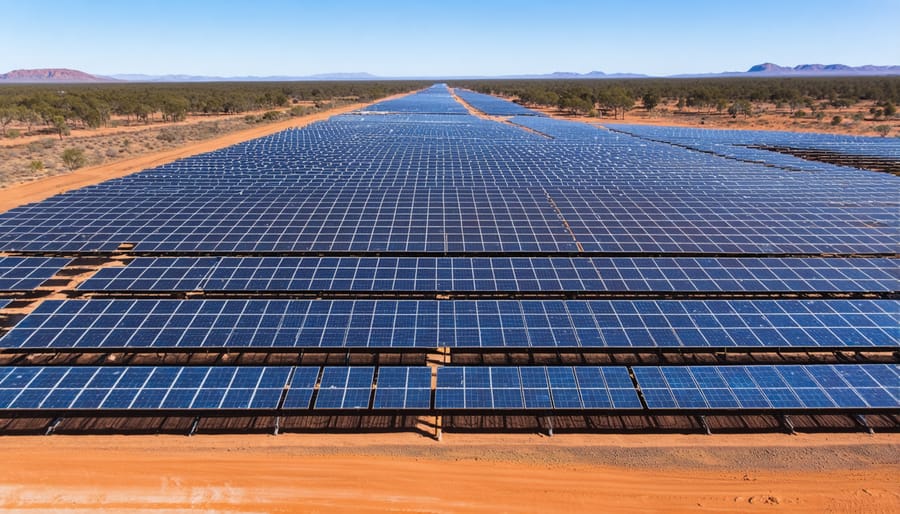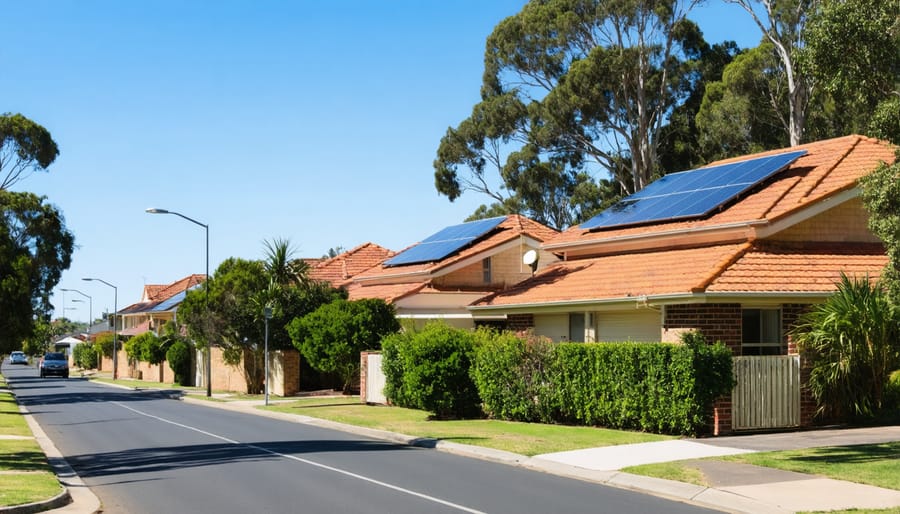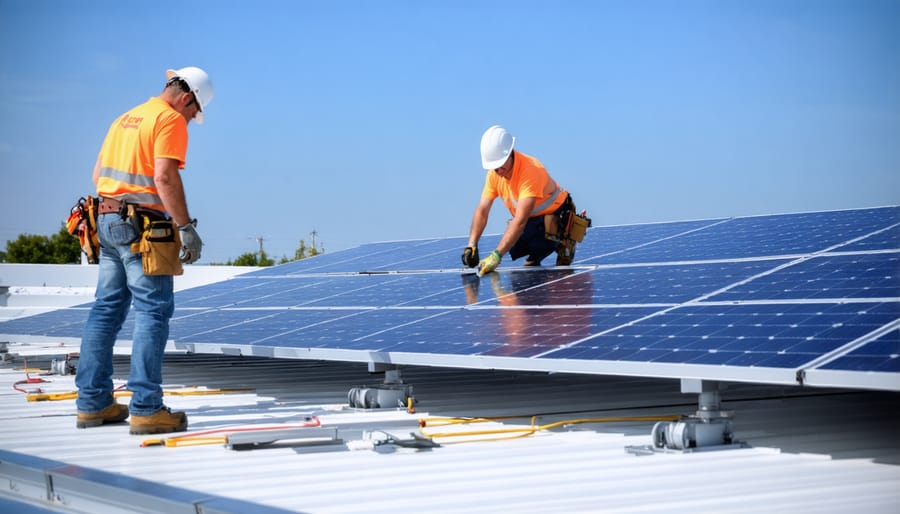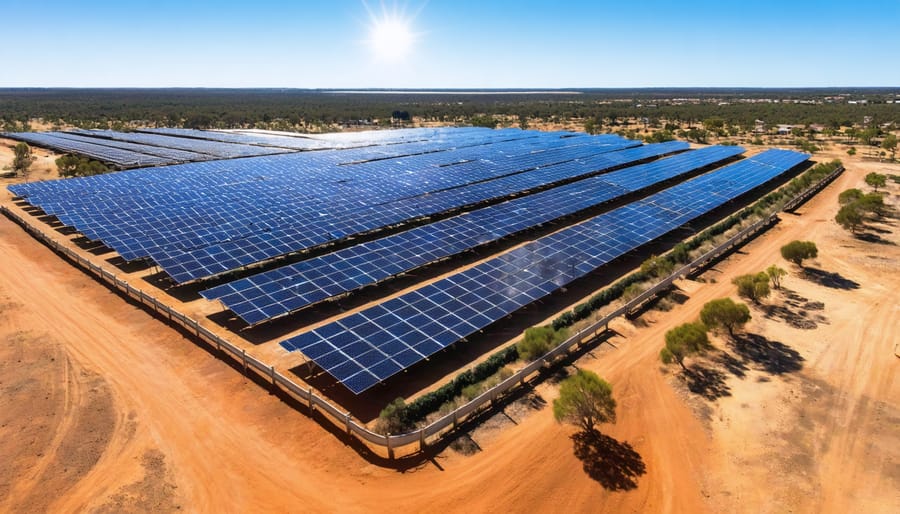Australia stands at the forefront of the global solar energy revolution, harnessing its abundant sunshine to power millions of homes and businesses across the continent. With more than 3 million rooftop solar installations nationwide and the highest per capita uptake of solar technology in the world, Australia’s solar success story showcases the remarkable transformation of a nation traditionally dependent on fossil fuels.
From the sun-drenched outback to suburban rooftops, Australia receives an average of 58 million petajoules of solar radiation annually – approximately 10,000 times more than its total energy consumption. This extraordinary solar potential, combined with dropping technology costs and innovative policies, has positioned Australia as a leader in renewable energy adoption.
In 2023, solar power accounts for over 15% of Australia’s total electricity generation, with some states achieving even higher percentages during peak sunlight hours. Major solar farms in Queensland, New South Wales, and Victoria, alongside widespread residential installations, demonstrate how solar energy has evolved from an alternative option to a mainstream power source.
This remarkable journey reflects not just environmental consciousness, but also practical economic sense, as Australian households and businesses increasingly recognize solar power as a smart investment in their energy future.
Australia’s Solar Energy Advantage
World-Class Solar Resources
Australia boasts some of the world’s most abundant solar resources, receiving an average of 58 million petajoules of solar radiation annually. This incredible amount of sunlight means that Australia experiences more solar radiation per square metre than virtually any other continent, making it an ideal location for solar energy generation.
The country’s vast desert regions and clear skies contribute to these exceptional conditions, with central and northwestern Australia receiving up to 24 megajoules per square metre each day. Major cities like Brisbane, Sydney, and Perth enjoy more than 300 days of sunshine per year, while even Melbourne, despite its reputation for variable weather, receives enough solar radiation to make solar installations highly effective.
These outstanding solar resources aren’t just concentrated in the outback – populated coastal areas receive 30-50% more sunlight than many European countries, including Germany, which has historically been a world leader in solar adoption. This abundant sunshine, combined with Australia’s large land mass and low population density, creates perfect conditions for both small-scale rooftop installations and utility-scale solar farms.

Perfect Climate for Solar Generation
Australia’s abundant sunshine and diverse climate zones create ideal conditions for solar energy generation. With more than 2,300 hours of sunshine annually in most regions, the continent receives nearly twice the solar radiation compared to Europe. The northern territories particularly excel, experiencing up to 3,000 hours of sunshine yearly, making them perfect for large-scale solar installations.
This natural advantage is enhanced by advanced renewable energy forecasting systems that help optimize solar power generation. Even during winter months, most Australian cities receive 4-5 hours of peak sun daily, ensuring consistent energy production year-round.
The country’s vast open spaces and clear skies contribute to optimal solar panel performance. Coastal areas benefit from sea breezes that naturally cool solar panels, improving their efficiency, while inland regions’ dry climate minimizes weather-related wear and tear. These favorable conditions, combined with decreasing technology costs, have made Australia a world leader in residential solar adoption, with one in four homes now equipped with rooftop systems.
Current Solar Installation Statistics
Residential Solar Growth
Australia’s residential solar uptake has experienced remarkable growth, with over 3.3 million rooftop solar installations completed by 2023. This impressive figure represents approximately one in three Australian homes now harnessing the power of the sun. The journey began modestly in the early 2000s, but installations surged dramatically from 2010 onwards as solar system components became more affordable and efficient.
Queensland leads the nation in residential solar adoption, with nearly 40% of suitable dwellings featuring rooftop panels, followed closely by South Australia and Western Australia. The average system size has also grown significantly, increasing from 2kW in 2010 to 8.3kW in 2023, reflecting both improved technology and growing energy needs.
This remarkable growth has been driven by several factors, including falling installation costs, rising electricity prices, and generous government incentives. The average household can now expect to recover their solar investment within 3-5 years, making it an increasingly attractive option for budget-conscious families.
Recent trends show a particular surge in battery storage adoption, with more homeowners combining solar panels with energy storage solutions to maximize their energy independence. This shift towards complete home energy systems represents the next evolution in Australia’s residential solar journey.

Commercial and Industrial Solar
Australian businesses are increasingly embracing solar energy, with commercial and industrial installations reaching record levels in recent years. As of 2023, over 15,000 Australian businesses have installed solar systems, ranging from small retail outlets to large manufacturing facilities. These installations not only include rooftop solar panels but also solar hot water systems and ground-mounted arrays.
Notable commercial solar projects include the Melbourne Markets’ 2.1MW system, which powers Australia’s largest wholesale fruit and vegetable market, and Adelaide Airport’s 1.17MW installation, demonstrating the versatility of solar in different business contexts. The mining sector has also embraced solar power, with Rio Tinto’s Weipa Solar Plant in Queensland becoming a pioneering example of integrating renewable energy into mining operations.
Shopping centres have become significant adopters, with Vicinity Centres installing over 48MW across their portfolio, helping reduce both carbon emissions and operating costs. The manufacturing sector has followed suit, with companies like Carlton & United Breweries powering their operations through solar installations.
Small and medium-sized enterprises (SMEs) are increasingly participating in this solar revolution, with many taking advantage of government incentives and reduced installation costs. The payback period for commercial solar installations typically ranges from 3-7 years, making it an attractive investment for businesses of all sizes.
Economic Impact and Job Creation

Employment Opportunities
The solar industry has become a significant employment driver in Australia, creating thousands of job opportunities across various sectors. As of 2023, the solar energy sector employs over 30,000 people nationwide, with roles ranging from installation technicians and electricians to project managers and sales professionals.
Small-scale solar installations, particularly in residential areas, have generated substantial employment opportunities for certified solar installers and electrical contractors. Large-scale solar farms are also creating jobs in regional areas, offering positions in construction, maintenance, and operations management.
The industry continues to expand, with projections indicating a 50% growth in employment opportunities by 2025. This growth isn’t limited to technical roles; the sector also needs professionals in engineering, finance, marketing, and customer service. Training institutions across Australia have responded by developing specialized courses and certification programs to meet the increasing demand for skilled solar professionals.
Remote and regional communities have particularly benefited from solar employment opportunities, with many Indigenous communities participating in solar installation and maintenance programs, creating sustainable local employment pathways.
Economic Benefits
Solar energy has become a significant economic driver in Australia, delivering substantial cost savings for both households and businesses. The average Australian household can save between $400 and $1,000 annually on electricity bills after installing solar panels, with the system typically paying for itself within 3-5 years. These savings continue to grow as electricity prices rise and solar technology becomes more efficient.
The solar industry has also created thousands of jobs across the country, with over 29,000 Australians employed in the sector as of 2023. From installers and maintenance technicians to researchers and sales professionals, the industry offers diverse employment opportunities. Small businesses have particularly benefited, with many reporting up to 60% reduction in operating costs after switching to solar power.
Property values have also seen a boost, with homes featuring solar installations commanding premium prices in the real estate market. Additionally, various government incentives and rebates make the initial investment more affordable, while feed-in tariffs allow households to earn money by feeding excess power back into the grid, creating a passive income stream for many Australian families.
Future Solar Projects and Initiatives
Major Solar Farms
Australia’s renewable energy landscape is being transformed by numerous major solar farm developments across the continent. The Western Downs Green Power Hub in Queensland stands as Australia’s largest solar farm, boasting an impressive 460MW capacity and powering over 230,000 homes. Close behind is the Darlington Point Solar Farm in New South Wales, generating 333MW of clean energy.
Victoria’s Kiamal Solar Farm represents another significant milestone, with its 200MW capacity complemented by ambitious battery storage plans. The Merredin Solar Farm in Western Australia showcases the west coast’s commitment to renewable energy, generating 132MW of power across its 780-hectare site.
Several groundbreaking projects are currently under construction or in advanced planning stages. The New England Solar Farm in NSW will become one of the largest in Australia upon completion, with a planned capacity of 720MW. The Wandoan South Solar Project in Queensland is set to add another 650MW to Australia’s renewable energy capacity.
These large-scale installations are creating thousands of jobs, boosting regional economies, and helping Australia meet its renewable energy targets. They represent not just power generation facilities, but catalysts for community development and environmental progress, demonstrating Australia’s leadership in solar energy adoption.
Government Support Programs
Australia’s commitment to solar energy is backed by robust government support programs at federal, state, and local levels. The Small-scale Renewable Energy Scheme (SRES) remains one of the country’s flagship initiatives, offering small-scale technology certificates (STCs) to reduce the upfront cost of solar installations by up to several thousand dollars.
State governments have introduced their own innovative programs to boost solar adoption. Victoria’s Solar Homes Program provides rebates and interest-free loans for solar panel installations, while New South Wales offers the Empowering Homes Program, supporting battery storage systems. Queensland’s regional feed-in tariffs continue to incentivize solar energy generation in remote areas.
Local councils across Australia are also stepping up with targeted initiatives. Many offer expedited permit processes for solar installations and additional rebates for low-income households. The City of Sydney, for example, has implemented the Solar for Business program, helping small businesses transition to solar power with matched funding.
For commercial installations, the federal government’s instant asset write-off scheme allows businesses to claim immediate deductions for solar investments, making the switch to solar more financially attractive. Additionally, the Clean Energy Finance Corporation provides specialized financing options for large-scale solar projects, ensuring continued growth in the commercial sector.
These support programs have been instrumental in making Australia a world leader in residential solar adoption, with one in four homes now equipped with rooftop solar systems.
Australia’s solar energy journey showcases a remarkable success story in renewable energy adoption. With over 3 million rooftop solar installations nationwide and some of the highest solar radiation levels globally, Australia continues to lead the world in household solar uptake. The nation’s commitment to solar power has resulted in significant achievements, including reduced carbon emissions, lower energy costs for consumers, and the creation of thousands of jobs in the renewable energy sector.
Looking ahead, Australia’s solar future appears exceptionally bright. Industry projections suggest that by 2030, solar energy could provide up to 50% of the country’s electricity needs. The continuing decline in solar panel costs, coupled with advancing battery storage technology, makes solar power an increasingly attractive option for both residential and commercial applications.
The success of large-scale solar farms, particularly in states like Queensland and New South Wales, demonstrates the viability of utility-scale solar projects. With increased government support, growing private sector investment, and strong public enthusiasm, Australia is well-positioned to maintain its position as a global solar energy leader.
As technology continues to evolve and efficiency improves, solar energy will play an even more crucial role in Australia’s energy mix. This transition not only supports environmental sustainability but also strengthens energy independence and economic growth, making Australia a shining example of successful renewable energy adoption worldwide.

